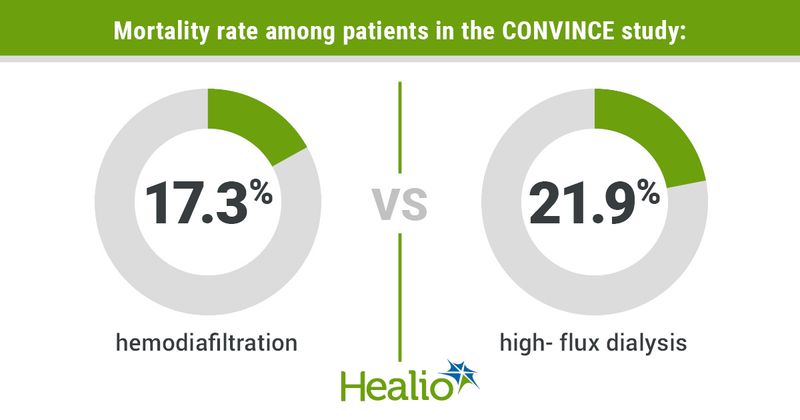Lower mortality rates found for patients using hemodiafiltration vs. high-flux dialysis
Key takeaways:
- A study of patients from eight European countries showed lower mortality when using high-dose hemodiafiltration vs. conventional high-flux dialysis.
- The CONVINCE trial had a 30-month follow-up.
Results from a study completed in eight European countries showed that patients receiving high-dose hemodiafiltration had lower mortality vs. patients using high-flux dialysis.
“Our results unequivocally demonstrate the survival benefits of utilizing hemodiafiltration over hemodialysis in the treatment of kidney failure, akin to a remarkable 23% reduction in all-cause mortality,” Peter J. Blankestijn, MD, of the department of nephrology and hypertension at the University Medical Centre Utrecht in the Netherlands and lead investigator of the study, said in a press release. “I am optimistic that hemodiafiltration can become the new standard of care."

Results of the CONVINCE trial, published in the New England Journal of Medicine, included a review of 1,360 patients across 61 dialysis centers. Researchers placed 683 patients on high-dose hemodiafiltration and 677 on high-flux hemodialysis three times a week from November 2018 through April 2021, according to the study.
The study identified death from any cause as the primary outcome. Patients in the study had been on hemodialysis at least 3 months prior to the study.
During a median follow-up of 30 months, “death from any cause occurred in 118 patients (17.3%) in the hemodiafiltration group and in 148 patients (21.9%) in the hemodialysis group,” Blankestijn and colleagues wrote. The difference of 4.6% represents a 23% reduction in the risk of death, according to the release.
The study is the first to compare the two dialysis methods, according to the release.
“Our trial differs from previous studies in that we enrolled patients who were likely candidates for high-dose hemodiafiltration nearly all the time,” Blankestijn and colleagues wrote. “We did not identify an association between failure to achieve the high-dose target and any particular patient characteristic or vascular access type. Thus, our trial results support the evidence that high-dose hemodiafiltration can result in a clinically important survival benefit.
“Furthermore,” they wrote, “since our trial was both randomized and controlled, our finding does not appear to be due to confounding according to indication.”
Conventional high-flux hemodialysis primarily employs diffusion to remove small molecules and fluid from the blood. High-dose hemodiafiltration incorporates both diffusion and convection techniques to eliminate larger molecules and effectively manage fluid replacement through convection, according to the release.
“This meticulously designed and executed clinical study unquestionably demonstrates the efficacy of high-volume hemodiafiltration for a significant portion of kidney failure patients,” Frank Maddux, MD, chief global medical officer of Fresenius Medical Care, said in a company press release. “These findings have the potential to prompt significant changes in the standard treatment approach and, most importantly, contribute to reducing mortality rates among this vulnerable population in need of kidney replacement therapy.” Patients from Fresenius, along with dialysis providers Diaverum and B. Braun Avitum, participated in the study.
Reference:
- Blankestijn P, et al. NEJM. 2023;doi:10.1056/NEJMoa2304820.
